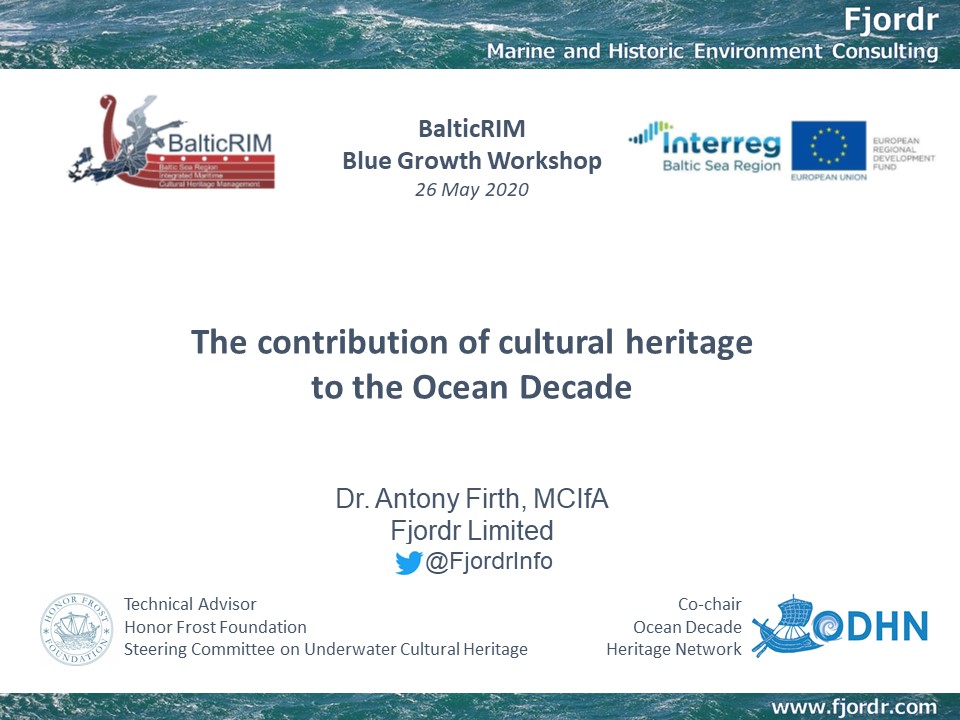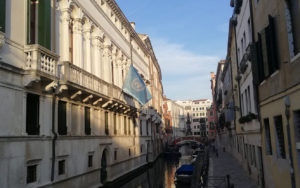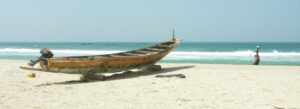Blue Growth Workshop: The contribution of cultural heritage to the Ocean Decade
26 May 2020
By Antony Firth, Co-chair, ODHN
Script of talk presented at the workshop:
Introduction
The relationship between cultural heritage and the Ocean Decade has many aspects. Today’s workshop focuses on Blue Growth, so I will concentrate on the relationship between cultural heritage and Blue Growth in the Ocean Decade; that is to say, I will focus on the contribution of cultural heritage to economic benefits within the context provided by the Ocean Decade.
The Ocean Decade and Sustainable Development
The Ocean Decade is concerned with obtaining greater economic benefits from the sea because the Ocean Decade is directly linked to sustainable development. The long title of the Decade is ‘Ocean Science for Sustainable Development’ and the Decade is framed in terms of the UN Sustainable Development Goals; the Ocean Decade forms part of the 2030 Agenda for sustainable development.
The SDGs consist of 17 goals, each of which have targets and indicators. These goals are of the most fundamental importance: they include ending hunger and ending poverty. Some of the SDGs are – like these – primarily economic; some are primarily social; and some are primarily environmental. This underlines the degree to which the 2030 Agenda reflects the three pillars of sustainable development: economic; social; and environmental.
I would like to flag two things: the goal that expressly addresses the marine environment is SDG 14, ‘Life below Water’; and there is no specific goal on culture or cultural heritage. Across the 17 goals, cultural heritage appears only as a target of SDG 11 ‘Sustainable Cities and Communities’.
On the face of it, the absence of reference to underwater cultural heritage in the SDGs might seem problematic. It might be regarded as even more problematic that cultural heritage appears under one SDG and the marine environment under another, such that our topic is split within the 2030 Agenda.
However, much of the emphasis in the 2030 Agenda – at least in what I have seen – is that they are to be dealt with as a whole: cultural heritage is being framed in terms of its relevance and contribution to all 17 SDGs. Similarly, the Ocean Decade is concerning itself with the contribution that ocean science can make to all 17 SDGs.
Nonetheless, we have to acknowledge that marine cultural heritage is usually a minor partner of land-based cultural heritage; and cultural heritage is usually a minor partner to the natural sciences in the marine environment. So even if culture and ocean science are seeking to demonstrate their relevance across the whole 2030 Agenda, it does not mean that marine cultural heritage will have an easy time. Marine cultural heritage does not automatically come to mind in the cultural heritage sector, or the ocean science sector.
There is, of course, a paradox here: public interest in marine cultural heritage is considerable; there is quite high awareness; and cultural heritage is often an integral characteristic of what people enjoy and seek out at the coast. Marine cultural heritage already makes a significant contribution to the environmental, social and economic pillars of sustainable development – at least in some places around the world. The paradox is that this is under-recognised and relatively little is done to support or enhance the contribution that marine cultural heritage already makes.
Much of our task is concerned, therefore, with taking an existing reality and representing it much more effectively in legislation, policy and resourcing so that the benefits that people obtain from marine cultural heritage can be substantially increased and extended.
I certainly feel that the Ocean Decade presents an opportunity to increase the contribution of cultural heritage to sustainable development. Indeed, we have also argued that cultural heritage is indispensable to the Ocean Decade if it wants to achieve its objectives. The Ocean Decade needs cultural heritage and the input of archaeologists in order to succeed.
I’m aware that you are familiar with the early documentation on the Ocean Decade, referred to as the ‘Roadmap’. The secretariat for the Ocean Decade is provided by the Intergovernmental Oceanographic Commission – IOC – which is part of the UNESCO family. IOC-UNESCO is currently working on the Implementation Plan for the Ocean Decade, which was made available as a ‘zero draft’ for consultation in April. I’m going to draw on this zero draft in the remainder of my presentation.
The vision for the Ocean Decade is ‘The science we need for the ocean we want’ while the mission is expressed as:
‘To generate and use knowledge for the transformational action needed to achieve a healthy, safe, and resilient ocean for sustainable development by 2030 and beyond’.
This mission statement reinforces the connection to the 2030 Agenda for sustainable development. I think is also worth underlining the phrase ‘transformational action’: the Ocean Decade is meant to cause major, fundamental changes: not just to tweak or improve current ways of working. Of course – the crises we are facing in terms of climate change, habitat degradation and global inequality are extremely urgent: anything less than transformative action risks being too little, too late.
The zero draft sets out six outcomes. The most relevant to Blue Growth is:
‘A productive and sustainably harvested ocean ensuring the provision of food supply and stable livelihoods’.
This outcome is clearly concerned with fisheries and the effort to achieve zero hunger (SDG 2) without causing complete collapse of life below water (SDG 14). However, setting aside fisheries production, this outcome can be paraphrased as ‘a productive ocean ensuring stable livelihoods’. This aligns especially with SDG 7 ‘decent work and economic growth’ but also SDG 1 ‘no poverty’, SDG 8 ‘reduced inequalities’, and SDG 11 ‘Sustainable cities and communities’. A productive ocean ensuring stable livelihoods also contributes to other economic, social and environmental goals: but I think this gives us an initial framework for testing the contribution cultural heritage and Blue Growth: how does marine cultural heritage contribute to
- decent work and economic growth
- no poverty
- reduced inequalities, and
- sustainable cities and communities
I will come back to this test in a little while. Next, however, I want to step through some of the work that has informed my own thinking about the relationship between cultural heritage and Blue Growth. I’m going to reference some of my own reports as supporting evidence, which I hope you don’t mind.
Marine Spatial Planning and the Historic Environment
One of the first pieces of work I carried out when I set up Fjordr was to look in detail at Marine Spatial Planning and the Historic Environment, in a commission for English Heritage (now Historic England). At the time – 2012 – the UK marine planning and licensing system was still quite new. I looked at the relationship between MSP and culture in its English context, but also in a UK, EU, European and International context.
I was already thinking about shifting focus from the environmental pillar of sustainability – which is traditionally the one we draw from in terms of rationale, language and legal/policy measures for managing cultural heritage – towards the economic and social pillars of sustainability. In a UK and EU context, my interest in shifting focus arose partly because the marine environment was being defined through the Marine Strategy Framework Directive (MSFD) in a way that did not include cultural heritage. I felt that, increasingly, we would not be able to count on the environmental pillar.
Considering MSP and planning more generally, I was more optimistic. In some respects, planning also regards cultural heritage in terms of the environmental pillar – as something that must be protected and conserved, and as a source of constraint. But planning is also about directing development – acknowledging activities that have economic and social benefits, and seeking to encourage them. And some of what I was reading – especially in an EU context – recognised the cultural heritage as an important source of economic value especially in terms of tourism and recreation.
Although the environmental grounds for conserving cultural heritage should not be diminished in any way, it was encouraging to see that (marine) cultural heritage could stand on its own feet in social and economic terms: to see a positive case for celebrating our cultural heritage.
The Social and Economic Value of the Marine Historic Environment
Social and Economic Benefits of Marine and Maritime Cultural Heritage
Consequently, I developed two related projects that were funded by the Honor Frost Foundation (Social and Economic Benefits of Marine and Maritime Cultural Heritage) and by English Heritage (The Social and Economic Value of the Marine Historic Environment) respectively. The projects addressed the need for evidence, especially quantitative evidence. I was aware of a rapidly growing literature on the social and economic benefits of cultural heritage on land; and of a growing literature on the social and economic benefits of the marine environment. But both seemed blind to the social and economic benefits of marine cultural heritage.
Such data as was available on marine cultural heritage pointed to a high level of benefits; but the data were often not sufficiently granular to be able to address the issue directly. The institutions collating data were not asking the right questions, so the contribution of marine cultural heritage was (and still is) being systematically ignored.
This work made the case for thinking about different types of engagement, each with different sources of social and economic benefits:
- Participants: employees and volunteers – employment numbers; salaries; direct earnings
- Visitors: temporary engagement with attractions, events and online material
- Inhabitants: practical rather than conscious engagement – contribution of heritage to sense of place, characterful environment etc.
These projects also emphasised the need to think about marine and maritime cultural heritage in a broad sense, across traditional boundaries: not just underwater, or maritime museums, or vessels in preservation, or port towns – but all of it together. I think this has echoes of what the BalticRIM has been doing with respect to ‘underwater landscapes’. This is important because appreciating what is underwater depends on making connections with things on land – paintings, drawings, documents, places etc. Increasing digital access and connectivity presents an especially important opportunity, so long as we overcome traditional boundaries between sub-disciplines.
Amongst the consequences of the projects on social and economic benefits was a Policy Forum in October 2016 with the title ‘The Seamless Sea’. This had two outputs: A Statement of Common Ground; and A Guide for Practitioners. I think these documents resonate with some of the outputs so far from BalticRIM, and I think you would find them interesting.
Managing Shipwrecks
Failing to recognise the existing value of marine cultural heritage was a motive for a further piece of work, that looked expressly at Managing Shipwrecks. An issue that we have in the UK – which I am sure must be familiar in the Baltic too – it that shipwrecks have multiple benefits (and disbenefits), each of which is addressed separately in law and administration. There is little mutual communication and opportunities to adopt a comprehensive and efficient approach to maximising benefits are lost. This often represents a loss of opportunity as much as unnecessary cost.
The Managing Shipwrecks project sought simply to map out all the different interests for the benefit principally of civil servants and politicians, to make the case for a more joined-up approach.
However, it again highlighted that the economic value of shipwrecks was probably high – especially in terms of recreational diving, sea angling and commercial fishing – but that direct and detailed quantitative data was not being collected. That is to say, in addition to their importance as cultural heritage, shipwrecks are already a major focus of economic activity; and if this were to be better recognised and enhanced, joined-up management of shipwrecks could contribute to Blue Growth whilst safeguarding other values and avoiding conflicts.
The approach taken in the Managing Shipwrecks report was intended to be applicable in other countries, providing a template and worked example that could be used to examine the administration and value of shipwrecks elsewhere. Again, this might be of interest to BalticRIM if you have not seen it already.
Heritage, Natural Capital and Ecosystem Services
The final project I want to mention addresses the application of another set of concepts to marine cultural heritage, namely Ecosystem Services and Natural Capital. These have become very influential in the UK in terms environmental law, policy and implementation, including in the marine environment. They are relevant to Blue Growth because the methodologies for Natural Capital and Ecosystem Services seek to apply economic values to the environment in order to manage them more sustainably. Natural Capital and Ecosystem Services can, therefore, be a source of economic data as well as requiring economic data themselves.
These concepts are becoming so influential in the UK that our heritage agency, Historic England, commissioned a series of case studies on their application to heritage in different environments. We were commissioned to carry out case studies on a river and on a coastal/marine area, which is in north east England between the Tyne and the Tees.
Natural Capital and Ecosystem Services approaches are problematic for heritage because, conceptually, they split nature and culture and emphasise nature as the source of all value – rather than recognising that our environment – as recognised in the European landscape Convention – is often a hybrid of natural and human processes. Natural Capital and Ecosystem Services are also not very good at dealing with time – and especially the degree of human interaction with the environment over millennia, not just a few decades. Nonetheless, it is possible to achieve a degree of reconciliation between the approaches.
I’ve been looking at ecosystem Services since some of the earliest work I’ve mentioned today, going back to the work on Marine Spatial Planning; it came up on the reports on social and economic benefits, and on managing shipwrecks too. The opportunity to look at this in detail and in the context of a specific case study was very informative. As well as looking at the ecosystem services arising from shipwrecks, including their value, I also considered the value of submerged prehistoric landscapes and, in particular, the services that arise from historic coastal infrastructure such as harbours, piers, promenades etc. In many cases, these features – which are heritage assets in their own right – provide a vital role in enabling access to the marine environment so that other services can be enjoyed: whether it is by shore angling or simply walking along the shore. Much of this activity – which is enjoyed by thousands of people especially on urban coasts – is informal. There are no ticket barriers, so it is difficult to quantify either the numbers involved or their economic impact. Nonetheless, I feel that this is an important area for research, to understand just how much value arises from out historic coastal infrastructure. And if we understand it better, we can work out how to look after it and improve its performance even more.
Collaborative PhD
A recent positive step that I want to highlight is that a new fully funded PhD is being offered at the University of Stirling in Scotland, to look in detail at the economic value of coastal heritage. The PhD is being supported collaboratively by Historic England and one of our Research Councils, and will be based in an economics department at Stirling with support also from their heritage department. Applications are open until 17 June [since extended to 1 July 2020], and I’m very much looking forward to the research that will be carried out.
Conclusion: the contribution of cultural heritage to Blue Growth
The Ocean Decade provides us with a ten-year opportunity to address the contribution of cultural heritage to Blue Growth. This issue is directly related to one of the Ocean Decade’s six outcomes: ‘a productive ocean ensuring stable livelihoods’. The Ocean Decade relates this outcome – and hence the role of cultural heritage in Blue Growth – to the 2030 Agenda for sustainable development. Moreover, the SDGs provide a framework through which we can test the contribution that cultural heritage makes to blue growth: providing decent work and economic growth, removing poverty, reducing inequality, and making cities and communities sustainable. This framework has the advantage of being global and having political weight behind it; whilst the Ocean Decade encourages us to take transformative action. We could hardly ask for a better platform upon which to make the case for the economic benefits of marine cultural heritage.
I am sure that, through the work of the BalticRIM project, you are confident that the case for the contribution of cultural heritage to Blue Growth and to the outcomes of the Ocean Decade can be made successfully. This is certainly my feeling from the projects I have outlined. We need not limit the justification for marine cultural heritage to the environmental pillar of sustainable development: we can make our own robust case for the social and economic benefits also. Although there has been relatively little detailed work on the economic benefits of marine cultural heritage itself, we can draw on work from cultural heritage on land and on the benefits of the marine environment. We need to make the case for suitable data on the economic value of marine cultural heritage to be gathered; but even existing data indicates that its value is high. It is helpful to think about different kinds of engagement between people and marine cultural heritage –bringing in a wide range of economic benefits; and it is important for us to integrate our data gathering – and resulting enhancements – across traditional boundaries between different forms of marine heritage. It is worth thinking further about the economic value that arises from marine cultural heritage from commercial fishing, sea angling and recreational diving – for example – even though this value does not arise entirely from their character as heritage. Similarly, at the coast, much of the value of historic coastal infrastructure may arise from the access it provides to the sea, rather than from its antiquity. Irrespective, recognising the economic value of such infrastructure could be very useful when making the case for conservation maintenance and repair. Approaches such as Ecosystem Services and Natural Capital are not well-suited conceptually for dealing with heritage, but a reconciliation can still be achieved, and this can help integrate consideration of marine cultural heritage within important policy discussions. There are many gaps in what we know and a strong case for novel research, but the Ocean Decade provides a solid platform and earlier work lends confidence to our case.
I would like to encourage you all to engage with the opportunity provided by the Ocean Decade, and to join with us in the Ocean Decade Heritage Network to share perspectives and experience as we move things forward.
Thank you.




